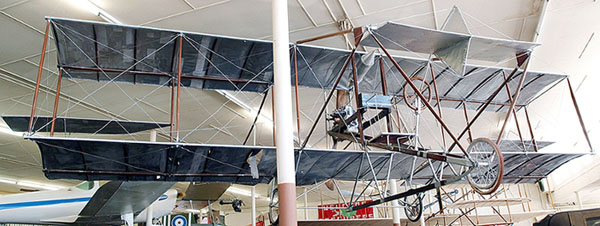Today, where would a wise man hide a leaf? The University of Houston's College of Engineering presents this series about the machines that make our civilization run, and the people whose ingenuity created them.
He would, of course, hide his leaf in a forest. The particular leaf that I recently found was a Glenn Curtiss aeroplane. Curtiss was the second American to build workable planes and first to succeed commercially. And one of his rare early aeroplanes appeared in a wholly unexpected forest -- in Minden, Nebraska. Minden is a town of three thousand, roughly halfway from Omaha to Cheyenne. Treeless cornfields stretch around Minden as far as the eye can see.

 Here one Harold Warp invented Flex-O-glass and went on to become very wealthy. He returned in 1953 to create a huge, twenty-acre museum meant to display the evolution of American Technology. It is, quite simply, the most remarkable and complete such museum I've seen. And I thought I'd seen them all.
Here one Harold Warp invented Flex-O-glass and went on to become very wealthy. He returned in 1953 to create a huge, twenty-acre museum meant to display the evolution of American Technology. It is, quite simply, the most remarkable and complete such museum I've seen. And I thought I'd seen them all.
Warp's Pioneer Village, as it's called, has been on my mind since 1994 when I first read about it. Then Elderhostel offered a trip to see a half million migrating sand hill cranes along the nearby Platte River, and we seized the opportunity. The cranes alone were well worth the adventure. But so was the museum.
Warp set out to show us America in the making -- to provide complete histories of transportation, domestic life, farm equipment, toys, sound recording, and crafts ... each spelled out in a chronological sequence of original artifacts. I read the most complete history of the bicycle that I've ever seen -- not in words, but in a sequence of actual bikes from throughout the nineteenth century. And that was only one small bay in a huge warehouse of a building. Another far smaller bay showed the evolution of -- the parking meter! Just try to imagine all 25 museum buildings! Warp's collecting was encyclopedic.
So, back to that 1910 Curtiss Pusher, Model D: It's made of canvas, wire, and sticks. The pilot sat out in the open on a flat wooden panel -- engine and propeller behind him and one control surface in front. This is flight at its most primitive even though it was then state-of-the-art. It seems light years behind his famous Curtiss Jenny, built only five years later. And, of course, I find a Jenny as well. There's the only civilian autogiro I've ever seen, and here's America's first jet airplane.


I've studied and taught the history of technology for years. And, after five lingering visits to this Aladdin's Cave, I could only come away grieving all the stones -- all the leaves -- left unturned.
It works differently, but equally powerfully, on the imagination of all the visitors whose interest is only casual. The Smithsonian Institution was once rightly called America's Attic. While it slides into the role of a theme park, that spirit lives in Minden, Nebraska. I only hope some new benefactor appears with Warp's understanding of all the leaves it takes to make a tree. For this remote attic of our rich heritage desperately needs to be sustained and developed into the coming centuries.
I'm John Lienhard at the University of Houston, where we're interested in the way inventive minds work.
This episode recalls an Elderhostel week with the Sand Hill Cranes and other birds -- a program run twice each year by Dr. Doyle Howitt, University of Nebraska at Kearny. My thanks to Marshall Nelson, Manager, and Monica Miller, Office Manager, Harold Warp Pioneer Village Museum, Minden, NE, for their very helpful counsel. All photos by J. Lienhard including one of a Harold Warp photo in the Museum.
The question, "Where does a wise man hide a leaf?" is posed by G. K. Chesterton's character, Father Brown in the short story titled, The Sign of the Broken Sword.


